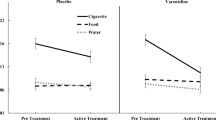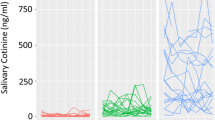Abstract
Novice and light adolescent smokers can develop symptoms of nicotine dependence, which predicts smoking behavior several years into the future. However, little is known about how the association between these early - emerging symptoms and later smoker behaviors may change across time from early adolescence into young adulthood. Data were drawn from a 7-year longitudinal study of experimental (<100 cigarettes/lifetime; N = 594) and light (100+ cigarettes/lifetime, but ≤5 cigarettes/day; N = 152) adolescent smokers. Time-varying effect models were used to examine the relationship between baseline nicotine dependence (assessed at age 15 ± 2 years) and future smoking frequency through age 24, after controlling for concurrent smoking heaviness. Baseline smoking status, race, and sex were examined as potential moderators of this relationship. Nicotine dependence symptoms assessed at approximately age 15 significantly predicted smoking frequency through age 24, over and above concurrent smoking heaviness, though it showed declining trends at older ages. Predictive validity was weaker among experimenters at young ages (<16), but stronger at older ages (20–23), relative to light smokers. Additionally, nicotine dependence was a stronger predictor of smoking frequency for white smokers around baseline (ages 14.5–16), relative to nonwhite smokers. Nicotine dependence assessed in mid-adolescence predicts smoking frequency well into early adulthood, over and above concurrent smoking heaviness, especially among novice smokers and nonwhite smokers. Early-emerging nicotine dependence is a promising marker for screening and interventions aimed at preventing smoking progression.



Similar content being viewed by others
References
Anderson, C. M., Burns, D. M., Dodd, K. W., & Feuer, E. J. (2012). Chapter 2: Birth-cohort-specific estimates of smoking behaviors for the U.S. population. Risk Analysis, 32, S14–24. doi:10.1111/j.1539-6924.2011.01703.x.
Center for Disease Control (2002). Cigarette smoking among adults- United States, 2000 Morbidity and Mortality Weekly Report (Vol. 51, pp. 642–645).
Clark, D. B., Wood, D. S., Martin, C. S., Cornelius, J. R., Lynch, K. G., & Shiffman, S. (2005). Multidimensional assessment of nicotine dependence in adolescents. Drug & Alcohol Dependence, 77, 235–242. doi:10.1016/j.drugalcdep.2004.08.019.
Dierker, L., & Mermelstein, R. (2010). Early emerging nicotine-dependence symptoms: A signal of propensity for chronic smoking behavior in adolescents. The Journal of Pediatrics, 156, 818–822. doi:10.1016/j.jpeds.2009.11.044.
Dierker, L., Hedeker, D., Rose, J., Selya, A., & Mermelstein, R. (2015). Early emerging nicotine dependence symptoms in adolescence predict daily smoking in young adulthood. Drug & Alcohol Dependence, 151, 267–271. doi:10.1016/j.drugalcdep.2015.03.009.
DiFranza, J. R., Rigotti, N. A., McNeill, A. D., Ockene, J. K., Savageau, J. A., St Cyr, D., & Coleman, M. (2000). Initial symptoms of nicotine dependence in adolescents. Tobacco Control, 9, 313–319. doi:10.1136/tc.9.3.313.
DiFranza, J. R., Savageau, J. A., Rigotti, N. A., Fletcher, K., Ockene, J. K., McNeill, A. D., & Wood, C. (2002). Development of symptoms of tobacco dependence in youths: 30 month follow up data from the DANDY study. Tobacco Control, 11, 228–235. doi:10.1136/tc.11.3.228.
DiFranza, J. R., Wellman, R. J., Mermelstein, R., Pbert, L., Klein, J. D., Sargent, J. D., & Winickoff, J. P. (2011). The natural history and diagnosis of nicotine addiction. Current Pediatric Reviews, 7, 88–96.
Doubeni, C. A., Reed, G., & Difranza, J. R. (2010). Early course of nicotine dependence in adolescent smokers. Pediatrics, 125, 1127–1133. doi:10.1542/peds.2009-0238.
Hu, M. C., Griesler, P. C., Wall, M. M., & Kandel, D. B. (2014). Reciprocal associations between cigarette consumption and DSM-IV nicotine dependence criteria in adolescent smokers. Addiction, 109, 1518–1528. doi:10.1111/add.12619.
Jefferis, B., Graham, H., Manor, O., & Power, C. (2003). Cigarette consumption and socio-economic circumstances in adolescence as predictors of adult smoking. Addiction, 98, 1765–1772.
Mercincavage, M., Branstetter, S. A., Muscat, J. E., & Horn, K. A. (2013). Time to first cigarette predicts cessation outcomes in adolescent smokers. Nicotine & Tobacco Research, 15, 1996–2004. doi:10.1093/ntr/ntt087.
O'Loughlin, J., DiFranza, J., Tyndale, R. F., Meshefedjian, G., McMillan-Davey, E., Clarke, P. B., & Paradis, G. (2003). Nicotine-dependence symptoms are associated with smoking frequency in adolescents. American Journal of Preventive Medicine, 25, 219–225.
Rath, J. M., Villanti, A. C., Abrams, D. B., & Vallone, D. M. (2012). Patterns of tobacco use and dual use in US young adults: The missing link between youth prevention and adult cessation. Journal of Environmental and Public Health, 2012, 679134. doi:10.1155/2012/679134.
Selya, A. S., Dierker, L. C., Rose, J. S., Hedeker, D., & Mermelstein, R. J. (2012a). Risk factors for adolescent smoking: Parental smoking and the mediating role of nicotine dependence. Drug & Alcohol Dependence. doi:10.1016/j.drugalcdep.2012.02.004.
Selya, A. S., Dierker, L. C., Rose, J. S., Hedeker, D., Tan, X., Li, R., & Mermelstein, R. J. (2012b). Time-varying effects of smoking quantity and nicotine dependence on adolescent smoking regularity. Drug & Alcohol Dependence. doi:10.1016/j.drugalcdep.2012.08.026.
Selya, A. S., Wakschlag, L. S., Dierker, L. C., Rose, J. S., Hedeker, D., & Mermelstein, R. J. (2013). Exploring alternate processes contributing to the association between maternal smoking and the smoking behavior among young adult offspring. Nicotine & Tobacco Research, 15, 1873–1882. doi:10.1093/ntr/ntt072.
Shiffman, S., Waters, A., & Hickcox, M. (2004). The nicotine dependence syndrome scale: A multidimensional measure of nicotine dependence. Nicotine & Tobacco Research, 6, 327–348. doi:10.1080/1462220042000202481.
Sterling, K. L., Mermelstein, R., Turner, L., Diviak, K., Flay, B., & Shiffman, S. (2009). Examining the psychometric properties and predictive validity of a youth-specific version of the Nicotine Dependence Syndrome Scale (NDSS) among teens with varying levels of smoking. Addictive Behaviors, 34, 616–619. doi:10.1016/j.addbeh.2009.03.016.
Tan, X., Shiyko, M. P., Li, R., Li, Y., & Dierker, L. (2012). A time-varying effect model for intensive longitudinal data. Psychological Methods, 17, 61–77. doi:10.1037/a0025814.
The Methodology Center (2015). TVEM SAS Macro Suite (Version 3.1.0) [Software]. University Park: The Methodology Center, Penn State. Retrieved from http://methodology.psu.edu
U.S. Department of Health and Human Services (2014). The Health Consequences of Smoking - 50 Years of Progress. A Report of the Surgeon General. Atlanta, GA: U.S Department of Health and Human Services, Centers for Disease Control and Prevention, National Center for Chronic Disease Prevention and Health Promotion, Office on Smoking and Health.
Wickham, H. (2009). ggplot2: Elegant graphics for data analysis. New York: Springer.
Author information
Authors and Affiliations
Corresponding author
Ethics declarations
Funding
This research was funded by Project Grant P01 CA098262 from the National Cancer Institute, R01 DA022313 and R21 DA029834 from the National Institute on Drug Abuse, and Center Grant P50 DA010075 awarded to Penn State University. The content is solely the responsibility of the authors and does not necessarily represent the official views of the NIH, NCI, or NIDA.
Conflict of Interest
The authors declare that they have no conflict of interest.
Ethical Approval
All procedures performed in studies involving human participants were in accordance with the ethical standards of the institutional and/or national research committee and with the 1964 Helsinki declaration and its later amendments or comparable ethical standards.
Informed Consent
Informed consent was obtained from all individual participants included in this study.
Rights and permissions
About this article
Cite this article
Selya, A.S., Dierker, L., Rose, J.S. et al. Early-Emerging Nicotine Dependence Has Lasting and Time-Varying Effects on Adolescent Smoking Behavior. Prev Sci 17, 743–750 (2016). https://doi.org/10.1007/s11121-016-0673-0
Published:
Issue Date:
DOI: https://doi.org/10.1007/s11121-016-0673-0




